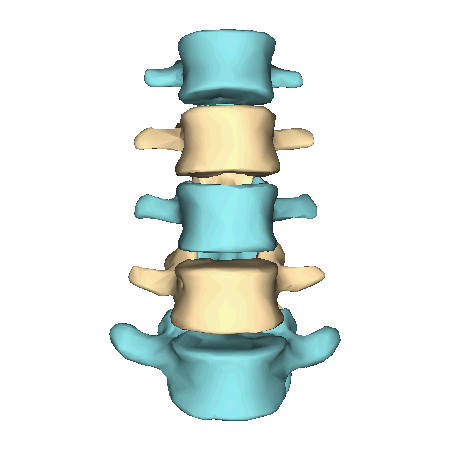As students begin to face the ever looming threat of finals they will hopefully be putting in more study time. This likely means more time sitting in chairs, hunched over with terrible posture. Too often the cries of students throughout libraries can be heard: “ow! my back”. While most people are aware of what bad posture looks like (have you ever been told to sit-up straight?), more often than not, the cause of back pain and likewise improper posture, goes unnoticed.
Many people can recognize one of the tell-tale signs of bad posture from curvature of the upper back; this is referred to as thoracic kyphosis. Though kyphosis on its own can lead to various forms of discomfort, its cause can be complicated, especially when in a seated position.
The lumbar spine is the lowest and strongest part of the spinal column. It is comprised of five vertebrae (though some people are born with six!) which remain largely immobile.
- Compare the thoracic (left) vertebrae with the lumbar (right). Note the ‘paddle’ like joints called facets which lock-in to one another to prevent rotation in the lumbar.
Obtained from Wikimedia commons.
When in a seated position, the hips are flexed and the pelvis is pulled under the body. This can force hyper-extension of the lumbar spine though a condition known as posterior pelvic tilt (PPT). Due to the extremely limited mobility of the lumbar spine, its extension will transfer force into the more mobile components of the spinal column (upper back, neck).
While the vertebrae of the upper back area (thoracic spine) do allow for movement through three planes (forwards/backwards, side-to-side, rotational), this movement is limited. In an attempt to maintain normal curvature of the spinal column, the hyperextension of the lumbar spine is often coupled with thoracic kyphosis. Unfortunately the problems associated with PPT and long bouts of sitting can be self-perpetuating. The backwards tilting of the pelvis can lead to short and stiff hamstrings, which in turn contribute to more, or difficult to treat posterior pelvic tilt. This coupling of muscular tightening and joint misalignment can be very uncomfortable.
There’s no getting around the fact that being a student comes with a four year contract of studying related back problems.
What then, can you do about this? The go-to move is usually a quick straightening of the back, or the dreaded twist until you hear a crack. While these options may seem to provide relief, the problem is probably coming from your pelvis. Every now and then take a study break and go for a short walk. Try to find some stairs; climbing stairs will help to get the musculature of the hips energised and re-engaged so as to support your pelvis. If you’re studying at home try some simple hip and back stretches. If you have access, use a foam roller to slowly and gently release the tight muscles along the entirety of your spine. However, if none of these options are available simply remember your mother’s advice: sit-up straight and take your elbows off the table!

For the anatomically inclined, check out this video for a more comprehensive view of the lumbar.
– Gregory McMaster








